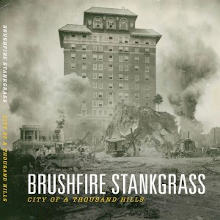The Graham Album Review #2028

Click on CD Cover for Audio Review in streaming mp3 format | |
Brushfire Stankgrass: City of a Thousand Hills
by George Graham
(Independent Records as broadcast on WVIA-FM 5/27/2020)

Click on CD Cover for Audio Review in streaming mp3 format | |
Brushfire Stankgrass: City of a Thousand Hills
by George Graham
(Independent Records as broadcast on WVIA-FM 5/27/2020)
Bluegrass-influenced groups have been part of the jam band scene for some time now. The String Cheese Incident have occasionally brought in some bluegrass sounds, and there are bluegrass groups who are essentially jam bands such as Railroad Earth, Leftover Salmon and Acoustic Syndicate. Another worthwhile group who incorporate the sound and instrumentation of bluegrass in their mix along with improvisational tendencies of the jam bands is the North Carolina-based group Brushfire Stankgrass, who have just released their third album called City of a Thousand Hills.
Asheville-based Brushfile Stankgrass was formed by two brothers, Ben and Will Saylor, who mainly play banjo and guitar respectively. Their bio says that they have been playing together since early childhood. The basic quartet on the new album also includes drummer Micah Thomas, and an addition since their last album, bassist Danny Iannucci. There are some added guests including a couple of fiddle players, backing vocalists and a mandolinist on one track.
Their previous album from 2014, Microclimates, showed the group to be admirably stylistically eclectic, with material running from a kind of bluegrass rock to a bit of reggae influence. Lyrically, the band touches on a number of topics you don’t often hear in a bluegrass setting, such as preservation of the environment, including their home state, and some bits of philosophy, plus a kind of hillbilly song about a dog. The group also brings in a kind of creative quirkiness that is rare in the bluegrass world.
Opening is one of those philosophical songs, Focus. Though it features a bluegrassy banjo, it’s more like an articulate rock composition. <<>>
The whimsical song about the dog is called Esther from Leicester which puts the band back in bluegrass hoedown territory. Esther is apparently a real dog who makes an appearance in the song. It’s a fun tune that band carries off well. <<>>
Brushfile Stankgrass incorporates some of Gordon Lightfoot’s The Wreck of the Edmund Fitzgerald in their song called Hurricane and gives Lightfoot credit in their liner notes. The band takes the tale of the storm to make a broader statement about climate change and its effect on the weather. <<>> The track also provides a chance for some instrumental soloing. <<>>
The album includes a kind of classic New Acoustic-style instrumental called Standing with tasteful playing all around. <<>>
About the closest thing the album has to a love song is a track called Two Hearts. It’s an interesting mix of influences, partly pre-rock nostalgia with a rock beat with the bluegrassy banjo and fiddle prominent. <<>>
The band rocks out Single Man, Tourist City, which is about pretty much what the title says. It turns out to be one of strongest tracks on the album, with more to it musically than just just the energy level. <<>>
Another of the most interesting tracks on the album is Cooper Dave. A cooper is a barrel maker, and the cooper in the song makes the barrels for booze. But it turns into a murder story. <<>>
The album ends with a song called North Carolina a nostalgic tribute to the band’s home state. <<>>
City of a Thousand Hills, the new third album by Brushfire Stankgrass is a satisfying record of eclectic bluegrass-influenced music that draws on numerous other genres for its pastiche of sounds. The material is creative both musically and lyrically, and the band’s level of musicianship rises to the occasion. Being a studio album, the tracks tend to be fairly succinct, so there is not much of an opportunity for the band to jam out, which is too bad. They could definitely use another instrumental or two like the track Standing.
Our sound quality grade is an “A-minus” with the acoustic instrumentation well captured and reasonably clean with a minimum of studio effects. The dynamic range, like so many current albums, falls short of audiophile level with volume compression flattening out some of the subtleties of the playing.
Interestingly, Brushfire Stankgrass recorded most of this album in 2018, only now releasing it, six years after their previous recording. It’s unclear why, but it’s good that it is out now and a good reminder that this band is among the best of the bluegrass-influenced groups finding an audience in the jam band scene.
(c) Copyright 2020 George D. Graham. All rights reserved.
This review may not be copied to another Web site without written permission.
 To Index of Album Reviews | To George Graham's Home Page. | What's New on This Site.
To Index of Album Reviews | To George Graham's Home Page. | What's New on This Site.